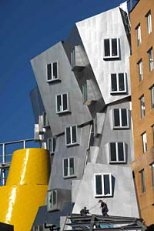The Ray and Maria Stata Center for Computer, Information, and Intelligence Sciences at MIT, designed by architect Frank Gehry, opens its doors on May 7. The 730,000-square-foot complex -- Gehry's largest building to date -- will be home to high-level research in computer science, linguistics and philosophy and usher in a new era of collaborative research and discovery at MIT.
"The time had come to build a facility, the physical form of which signaled the intellectual brashness, energy and excellence held within," noted MIT President Charles M. Vest, referring in part to Stata's unique architectural form and sculptured shapes.
"More than 50 years ago, Alvar Aalto's Baker House established a tradition of innovative, adventurous architecture on MIT's Cambridge campus," commented William J. Mitchell, head of the Media Arts and Sciences Program and architecture advisor to President Vest. "Today, the opening of Frank Gehry's Stata Center extends that tradition and re-invents it for the 21st century."
The Stata Center is built on the site of MIT's beloved Building 20, a "temporary" timber-framed building constructed during World War II and later nicknamed the "Magical Incubator" by its residents. Building 20 was a breeding ground for new ideas and innovative research and played a profound role in MIT's academic history.
It is hoped that the Stata Center, like Building 20, will foster collaboration among students and faculty and stimulate invention and the exchange of ideas across many disciplines. "The goal of Stata's design was to create spaces in which the mind would be free, where walls could be moved, rooms reconfigured, and students and faculty alike could benefit from the best and most stimulating work environment," commented Chris Terman, Associate Director of the Computer Science and Artificial Intelligence Laboratory.
The idea for Stata arose in the early 1990s, as a means to bring MIT's computer scientists, working in off-campus commercial office space for almost 30 years, onto the main MIT campus. A new building program was also needed to revitalize the northeast sector of the MIT campus, near the corner of Vassar and Main streets. The Stata Center opens up this part of the campus to the surrounding communities and shapes a new gateway into MIT, linking the burgeoning Technology Square and Kendall Square technology communities across Main Street with the main campus.
The building's neighbors include departments, labs and centers that are doing increasingly interrelated work in fields such as biological engineering, physics and neuroscience. MIT's new brain and cognitive sciences project, located across the street from Stata, will be completed next year. Pharmaceuticals giant Novartis recently relocated its main headquarters in Technology Square, joining dozens of new technology and biotech companies in the area.
The Stata Center is designed as a functional yet flexible work environment for its three main tenants, the Computer Science and Artificial Intelligence Laboratory (CSAIL), the Laboratory for Information and Decision Systems (LIDS) and the Department of Linguistics and Philosophy. Its massing features two towers (the Gates and the Dreyfoos buildings), with office and research labs sitting on a common two-level platform known as the "warehouse." Double-height lounges and gathering areas define two-story "neighborhoods" within the towers, home to different research groups. A "town square" on the fourth and fifth levels provides meeting and socializing opportunities, and a skylit "Student Street," a public arcade for the MIT community, runs the entire length of the ground floor.
Gehry's design for Stata emphasizes ease of movement, extensive natural lighting, unique interior views and informal gathering spaces. A series of cascading garden terraces form a landscaped hillside with a view back toward the main MIT campus, and a large outdoor amphitheater provides seating for lunch-time crowds. There is also a cafe, a childcare center for 80 children, a fitness center, a faculty dining area and many other related facilities.
There are several whimsical spaces, including a "holodeck" with lab space for large-scale experiments in graphics and vision systems, a "nose" in the shape of a mirrored cylinder which will serve as a robotics lab, and two large cone-shaped seminar rooms.
Frank Gehry recently wrote of Stata, "it reflects the different groups, the collision of ideas, the energy of people and ideas. They each have their own sort of vectors and they will all be colliding with each other, some accidentally and some by contrivance. That's what will lead to the breakthroughs and the positive results."
The Stata center is the newest building to open as part of MIT's ongoing, $1 billion building program, which will ultimately involve more than a dozen major building projects and renovations that will transform the look and feel of the campus. This architectural metamorphosis will support what is most unique about MIT -- its ability to use leading-edge science and technology to help solve some of the world's most challenging problems.
The Stata Center was made possible through a generous gift by Ray Stata (Class of 1957) and Maria Stata. Ray Stata is co-founder and chairman of Analog Devices and a member of the MIT Corporation. Other major donors are the Bill and Melinda Gates Foundation and Alexander W. Dreyfoos Jr. (Class of 1954), chairman of the Dreyfoos Group/Photo Electronics Corporation and a member of the MIT Corporation.






